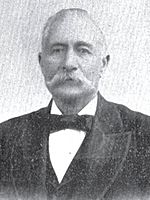Horton D. Haight facts for kids
Quick facts for kids Horton D. Haight |
|
|---|---|
 |
|
| Utah territorial legislature | |
| In office | |
| 1861 | |
| Personal details | |
| Born | Horton David Haight June 20, 1832 Moravia, New York, United States |
| Died | January 19, 1900 (aged 67) Oakley, Idaho, United States |
| Resting place | Oakley Cemetery 42°13′58″N 113°52′27″W / 42.2327°N 113.8742°W |
| Occupation | Sheriff |
| Employer | Davis County |
| Spouse(s) | Louise (née Leavitt) Haight |
| Parents | Hector Caleb Haight Julia Ann (née Van Orden) |
Horton David Haight (born June 20, 1832 – died January 19, 1900) was an important Mormon pioneer. He first came to Utah in 1847 when he was 14 years old. He traveled with Daniel Spencer's group of immigrants.
Later, Horton Haight was in charge of a freight company. This company brought goods to the Utah Territory in 1859. He also led four "down-and-back" companies in the 1860s. These special companies sent wagons from Utah to help new settlers. They brought new immigrants, their bags, and their goods back to Utah.
Horton D. Haight's Story
Horton Haight was born in Moravia, Cayuga County, New York. His parents were Hector Caleb Haight and Julia Ann (née Van Orden). In 1837, his family moved to Illinois. They joined The Church of Jesus Christ of Latter-day Saints (LDS Church) in 1845. After that, they moved to Nauvoo.
Early Life and Pioneer Journeys
In 1848, Horton was part of a group sent to help Latter-day Saints on their journey. They were traveling to Salt Lake City. Later, in 1857, he worked with Lot Smith. They helped slow down the approach of Johnston's Army. This was during a time of conflict in Utah.
Horton Haight lived for many years in Farmington, Utah. His wife, Louise (née Leavitt) Haight, was also an important person. She was a helper to Aurelia Spencer Rogers. Together, they organized the first Primary in Farmington. The Primary is a children's organization in the LDS Church. Louise's family also had strong ties to the LDS Church. Her father was Weare Leavitt, and her mother was Phoebe (née Cowles) Leavitt.
Public Service and Leadership
Horton Haight served his community in several ways. He was the sheriff for Davis County. In 1861, he also served in the Utah territorial legislature. This was a group of people who made laws for the Utah Territory.
In 1882, John Taylor, the president of the LDS Church, sent Horton Haight to Oakley, Idaho. There, Horton served as a bishop until 1887. A bishop is a local leader in the LDS Church. After that, he became the president of the new Cassia Stake. A stake is a larger group of church congregations. He served as stake president until he passed away in 1900. Horton Haight also worked as a county commissioner in Cassia County, Idaho. This role involved managing local government.
One of Horton Haight's grandsons was David B. Haight. David B. Haight later became an apostle in the LDS Church. An apostle is a high-ranking leader in the church.

